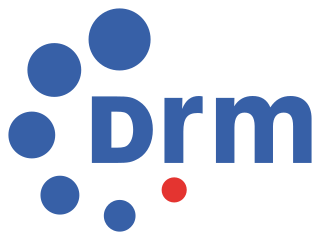Related Research Articles

MPEG-2 is a standard for "the generic coding of moving pictures and associated audio information". It describes a combination of lossy video compression and lossy audio data compression methods, which permit storage and transmission of movies using currently available storage media and transmission bandwidth. While MPEG-2 is not as efficient as newer standards such as H.264/AVC and H.265/HEVC, backwards compatibility with existing hardware and software means it is still widely used, for example in over-the-air digital television broadcasting and in the DVD-Video standard.
Dolby Digital, originally synonymous with Dolby AC-3, is the name for a family of audio compression technologies developed by Dolby Laboratories. Called Dolby Stereo Digital until 1995, it is lossy compression. The first use of Dolby Digital was to provide digital sound in cinemas from 35 mm film prints. It has since also been used for TV broadcast, radio broadcast via satellite, digital video streaming, DVDs, Blu-ray discs and game consoles.

Digital Video Broadcasting (DVB) is a set of international open standards for digital television. DVB standards are maintained by the DVB Project, an international industry consortium, and are published by a Joint Technical Committee (JTC) of the European Telecommunications Standards Institute (ETSI), European Committee for Electrotechnical Standardization (CENELEC) and European Broadcasting Union (EBU).
Advanced Audio Coding (AAC) is an audio coding standard for lossy digital audio compression. It was designed to be the successor of the MP3 format and generally achieves higher sound quality than MP3 at the same bit rate.
DVB-T, short for Digital Video Broadcasting – Terrestrial, is the DVB European-based consortium standard for the broadcast transmission of digital terrestrial television that was first published in 1997 and first broadcast in Singapore in February, 1998. This system transmits compressed digital audio, digital video and other data in an MPEG transport stream, using coded orthogonal frequency-division multiplexing modulation. It is also the format widely used worldwide for Electronic News Gathering for transmission of video and audio from a mobile newsgathering vehicle to a central receive point. It is also used in the US by Amateur television operators.
Digital Video Broadcasting - Cable (DVB-C) is the DVB European consortium standard for the broadcast transmission of digital television over cable. This system transmits an MPEG-2 or MPEG-4 family digital audio/digital video stream, using a QAM modulation with channel coding. The standard was first published by the ETSI in 1994, and subsequently became the most widely used transmission system for digital cable television in Europe, Asia and South America. It is deployed worldwide in systems ranging from the larger cable television networks (CATV) down to smaller satellite master antenna TV (SMATV) systems.

Advanced Television Systems Committee (ATSC) standards are an International set of standards for broadcast and digital television transmission over terrestrial, cable and satellite networks. It is largely a replacement for the analog NTSC standard and, like that standard, is used mostly in the United States, Mexico, Canada, South Korea and Trinidad & Tobago. Several former NTSC users, such as Japan, have not used ATSC during their digital television transition, because they adopted other systems such as ISDB developed by Japan, and DVB developed in Europe, for example.

Digital Radio Mondiale is a set of digital audio broadcasting technologies designed to work over the bands currently used for analogue radio broadcasting including AM broadcasting—particularly shortwave—and FM broadcasting. DRM is more spectrally efficient than AM and FM, allowing more stations, at higher quality, into a given amount of bandwidth, using xHE-AAC audio coding format. Various other MPEG-4 codecs and Opus are also compatible, but the standard now specifies xHE-AAC.

Dolby Laboratories, Inc. is a British-American technology corporation specializing in audio noise reduction, audio encoding/compression, spatial audio, and HDR imaging. Dolby licenses its technologies to consumer electronics manufacturers.

High-Efficiency Advanced Audio Coding (HE-AAC) is an audio coding format for lossy data compression of digital audio defined as an MPEG-4 Audio profile in ISO/IEC 14496–3. It is an extension of Low Complexity AAC (AAC-LC) optimized for low-bitrate applications such as streaming audio. The usage profile HE-AAC v1 uses spectral band replication (SBR) to enhance the modified discrete cosine transform (MDCT) compression efficiency in the frequency domain. The usage profile HE-AAC v2 couples SBR with Parametric Stereo (PS) to further enhance the compression efficiency of stereo signals.

1080p is a set of HDTV high-definition video modes characterized by 1,920 pixels displayed across the screen horizontally and 1,080 pixels down the screen vertically; the p stands for progressive scan, i.e. non-interlaced. The term usually assumes a widescreen aspect ratio of 16:9, implying a resolution of 2.1 megapixels. It is often marketed as Full HD or FHD, to contrast 1080p with 720p resolution screens. Although 1080p is sometimes referred to as 2K resolution, other sources differentiate between 1080p and (true) 2K resolution.

DTS, Inc. is an American company. DTS company makes multichannel audio technologies for film and video. Based in Calabasas, California, the company introduced its DTS technology in 1993 as a competitor to Dolby Laboratories, incorporating DTS in the film Jurassic Park (1993). The DTS product is used in surround sound formats for both commercial/theatrical and consumer-grade applications. It was known as The Digital Experience until 1995. DTS licenses its technologies to consumer electronics manufacturers.
Dolby Digital Plus, also known as Enhanced AC-3, is a digital audio compression scheme developed by Dolby Labs for the transport and storage of multi-channel digital audio. It is a successor to Dolby Digital (AC-3), and has a number of improvements over that codec, including support for a wider range of data rates, an increased channel count, and multi-program support, as well as additional tools (algorithms) for representing compressed data and counteracting artifacts. Whereas Dolby Digital (AC-3) supports up to five full-bandwidth audio channels at a maximum bitrate of 640 kbit/s, E-AC-3 supports up to 15 full-bandwidth audio channels at a maximum bitrate of 6.144 Mbit/s.
MPEG Multichannel, also known as MPEG-2 Backwards Compatible, or MPEG-2 BC, is an extension to the MPEG-1 Layer II audio compression specification, as defined in the MPEG-2 Audio standard which allows it provide up to 5.1-channels of audio. To maintain backwards compatibility with the older 2-channel (stereo) audio specification, it uses a channel matrixing scheme, where the additional channels are mixed into the two backwards compatible channels. Extra information in the data stream contains signals to process extra channels from the matrix.
MPEG Surround, also known as Spatial Audio Coding (SAC) is a lossy compression format for surround sound that provides a method for extending mono or stereo audio services to multi-channel audio in a backwards compatible fashion. The total bit rates used for the core and the MPEG Surround data are typically only slightly higher than the bit rates used for coding of the core. MPEG Surround adds a side-information stream to the core bit stream, containing spatial image data. Legacy stereo playback systems will ignore this side-information while players supporting MPEG Surround decoding will output the reconstructed multi-channel audio.
ATSC-M/H is a U.S. standard for mobile digital TV that allows TV broadcasts to be received by mobile devices.
Unified Speech and Audio Coding (USAC) is an audio compression format and codec for both music and speech or any mix of speech and audio using very low bit rates between 12 and 64 kbit/s. It was developed by Moving Picture Experts Group (MPEG) and was published as an international standard ISO/IEC 23003-3 and also as an MPEG-4 Audio Object Type in ISO/IEC 14496-3:2009/Amd 3 in 2012.
MPEG-H 3D Audio, specified as ISO/IEC 23008-3, is an audio coding standard developed by the ISO/IEC Moving Picture Experts Group (MPEG) to support coding audio as audio channels, audio objects, or higher order ambisonics (HOA). MPEG-H 3D Audio can support up to 64 loudspeaker channels and 128 codec core channels.
References
- 1 2 3 4 5 6 7 8 9 10 11 12 13 14 "Dolby AC-4: Audio Delivery for Next-Generation Entertainment Services" (PDF). Dolby Laboratories. 2015-06-01. Archived from the original (PDF) on 2015-12-04. Retrieved 2016-04-26.
- ↑ John Archer (2015-09-14). "How Dolby Plans To Revolutionize The Sound On Your Tablet, Smartphone And TV". Forbes . Retrieved 2016-04-26.
- ↑ "Advanced Television Systems Committee Begins Review of ATSC 3.0 Audio System Proposals". Advanced Television Systems Committee. 2015-03-10. Retrieved 2016-04-26.
- ↑ "VIZIO and Sony Visual Products Adopt Dolby AC-4". Business Wire. 2015-07-14. Retrieved 2016-04-26.
- ↑ "Dolby Announces Samsung Commitment to Bring Dolby AC-4 Enabled Televisions to Market". Business Wire. 2016-04-14. Retrieved 2016-04-26.
- ↑ "Dolby AC-4: Audio Delivery for Next-Generation Entertainment Services" (PDF). Dolby Laboratories . June 2015. Archived from the original (PDF) on 30 May 2019. Retrieved 11 November 2019.
- ↑ https://www.itu.int/dms_pubrec/itu-r/rec/bs/R-REC-BS.1196-7-201901-S!!PDF-E.pdf [ bare URL PDF ]
- 1 2 3 4 Giles Baker (2018-04-11). "Setting the record straight on Dolby AC-4 and MPEG-H". Dolby Laboratories. Retrieved 2019-11-05.